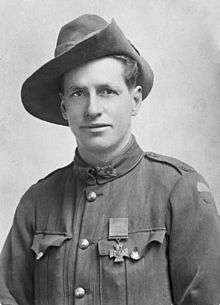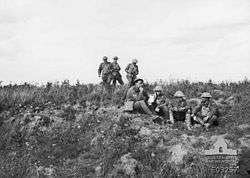48th Battalion (Australia)
| 48th Battalion (Australia) | |
|---|---|
|
Soldiers from the 48th Battalion before their final attack at Le Verguier, September 1918 | |
| Active |
1916–19 1921–30 1930–42 (43rd/48th Battalion) 1942–43 1943–45 (10th/48th Battalion) 1952–60 (43rd/48th Battalion) |
| Country | Australia |
| Branch | Australian Army |
| Type | Infantry |
| Size | ~800–1,000 officers and men |
| Part of |
12th Brigade 4th Division |
| Engagements |
World War I World War II |
| Insignia | |
| Unit Colour Patch |
|
The 48th Battalion was an infantry battalion of the Australian Army. It was originally raised in 1916 for service during World War I and took part in the fighting in the trenches of the Western Front in France and Belgium, before being disbanded in early 1919. After the war, the battalion was re-raised as a part-time unit based initially in Victoria and later in South Australia. In 1930 it was amalgamated with the 43rd Battalion and remained so until mid-1942, subsequently being linked with the 10th Battalion. The battalion did not see combat during World War II, and after the war was re-raised as an amalgamated unit, again with the 43rd Battalion, in 1952. They remained linked until 1960 when the 43rd/48th Battalion was subsumed by the Royal South Australia Regiment.
History
World War I
The 48th Battalion was raised in Egypt on 16 March 1916 as part of the reorganisation and expansion of the Australian Imperial Force (AIF) following the Gallipoli campaign.[1] This was achieved by transferring cadres of experienced personnel predominately from the 1st Division to the newly formed battalions and combining them with recently recruited personnel who had been dispatched as reinforcements from Australia.[2] The unit's first intake of personnel were drawn from men originating from South Australia and Western Australia, many of whom had already served with the 16th Battalion. Under the command of Lieutenant Colonel Raymond Leane, formerly of the 11th Battalion,[3] the battalion became part of the 12th Brigade attached to the 4th Australian Division.[4] Several of Leane's relatives, including his brother, Benjamin, who served as adjutant, and three of his nephews – Allan, Reuben, and Geoffrey – and a few others, also served in the 48th. As a result, the battalion became known as the "Joan of Arc battalion", which was a play on words because it was seemingly "made of all Leanes".[5]

Throughout March and April 1916, the battalion undertook training in the desert before being moved to Habieta in early May where they briefly manned defensive positions as a precaution against a possible Ottoman attack on the Suez Canal.[6] On 1 June, after a preliminary march to Serapeum, the battalion was moved by rail to Alexandria and boarded the troopship Caledonia, which sailed for France two days later. They docked at Marseilles on 9 June, after which they were moved to northern France by rail.[7]
In July and August, the battalion was committed to the fighting along the Western Front for the first time, taking part in the Battle of Pozières, during which it suffered 598 casualties out of its complement of just over 1,000 men.[4][8] Following this, it undertook a defensive role around Mouquet Farm,[4] before being moved to Flanders where they rotated with the other three battalions of the brigade to man a sector of the line south of Ypres. No major attacks occurred in their sector during this time, and although there were a few casualties, the battalion was able to replace some of its losses, reaching a strength of around 700 men.[9]
After enduring the worst European winter in 40 years, during which they continued to take their turn at the front line, in March 1917 the battalion followed up the Germans as they withdrew towards the Hindenburg Line.[10] A new defensive line was established further west and early the following month the battalion attacked around Bullecourt, suffering 435 casualties.[11] Its next major battle came around Passchendaele in October.[12] With three companies forward and one in reserve, the battalion advanced steadily in its sector, taking over 200 prisoners. As the advance stalled on their left, the battalion was caught in a German counterattack and suffered heavily, losing 369 men killed or wounded, out of the 621 men involved.[13]
After Passchendaele, the battalion was withdrawn out of the line throughout the winter, before being moved to Belgium in January 1918.[14] In March 1918, following the collapse of Russia, the Germans launched the "Spring Offensive", a major operation on the Western Front. As the Allies were pushed back, the 48th Battalion undertook a defensive role around Dernancourt, blocking the Amiens Road,[15] before joining the final Allied offensive around Amiens in August. It was withdrawn from the line in mid-September and did not see action again before the war ended in November. During its last battle, at Le Verguier, north-west of St. Quentin, Private James Woods performed the deeds that resulted in him receiving the Victoria Cross.[16] The 48th Battalion was disbanded on 31 March 1919. During the fighting, it suffered lost 843 killed in action or died on active service and 1,628 wounded.[4]
Members of the battalion received the following decorations: one VC, one Companion of the Order of St Michael and St George, four Distinguished Service Orders, 36 Military Crosses, 23 Distinguished Conduct Medals, 177 Military Medals, three Meritorious Service Medals, eight French Croix de Guerres; one Belgian Croix de Guerre; one Serbian award and one Russian award.[17] A total of 16 battle honours were awarded to the 48th Battalion in 1927 for its involvement in the war.[18]
Inter-war years and World War II
In 1921, the battalion was re-raised as part the re-organisation of the Australian military that took place at that time. Assigned to the 3rd Military District, the battalion was raised as a part-time unit in Victoria, drawing personnel from the Citizen Forces' 5th Battalion, 24th Infantry Regiment.[18] Following a re-organisation, the Victorian-based 48th Battalion became the 52nd Battalion and the 48th Battalion was re-raised in South Australia from the 32nd Infantry Regiment (Torrens Regiment), which traced its lineage back to the 79th Infantry (Torrens Battalion).[19] In 1927, the battalion adopted the territorial designation of the "Torrens Regiment" and the motto Nunquam Victis, and was officially entrusted with battle honours from World War I. In 1930, an alliance with the Northamptonshire Regiment was formed.[19] Later that year, amidst the austerity of the Great Depression and following the election of the Scullin Labor government, the compulsory training scheme was suspended,[20] and the decision was made to amalgamate the battalion due to a decline in the numbers of volunteers. At this time it was merged with the 43rd Battalion, to become the "43rd/48th Battalion".[21][22]
Throughout the early part of World War II, these battalions remained linked, undertaking garrison duties in Australia. On 27 August 1942, the 43rd/48th Battalion was split and both battalions reformed in their own right. The following year, the battalion was amalgamated with the 10th Battalion, becoming the "10th/48th Battalion". Despite being gazetted as an "AIF" battalion, which meant that it could be deployed outside Australian territory as its personnel volunteered for service overseas,[23] the 10th/48th Battalion did not take part in any fighting during the war and was disbanded on 8 August 1945.[19]
Post World War II
In 1948, following the demobilisation of Australia's wartime military, the part-time forces were re-raised under the guise of the Citizens Military Force (CMF),[24] but the 48th Battalion was not re-raised until August 1952, forming an amalgamated until with the 43rd Battalion, known as the "43rd/48th Infantry Battalion (The Hindmarsh Regiment)".[25] On 1 July 1960, a widespread re-organisation of the CMF resulted in the creation of six State-based multi-battalion regiments as the smaller, regional regiments of the past were consolidated.[26] As a result, the 43rd/48th Battalion became subsumed into the Pentropic 1st Battalion, Royal South Australia Regiment, providing one company: 'C' (The Mid North Company).[25] Although it was no longer on the Australian Army's order of battle, in 1961, the 48th Battalion was entrusted with the 14 battle honours that the 2/48th Battalion, received for its involvement in the fighting in North Africa, New Guinea and Borneo during World War II.[18]
Battle honours
The 48th Battalion was awarded the following battle honours:[18]
- World War I: Somme 1916–18, Pozières, Bullecourt, Messines 1917, Ypres 1917, Menin Road, Polygon Wood, Passchendaele, Ancre 1918, Hamel, Amiens, Albert 1918, Hindenburg Line, Épehy, France and Flanders 1916–18, Egypt 1915–16.[4]
- World War II: North Africa 1941–42, Defence of Tobruk, El Adem Road, The Salient 1941, Defence of Alamein Line, Tell el Eisa, El Alamein, South-West Pacific 1943–45, Lae–Nadzab, Finschhafen, Defence of Scarlet Beach, Sattelberg, Borneo, Tarakan (inherited).[18]
Notes
- ↑ Bean 1941, p. 42.
- ↑ Grey 2008, pp. 99–100.
- ↑ Devine 1919, p. 2.
- 1 2 3 4 5 Australian War Memorial.
- ↑ Hopkins 1986, pp. 39–41.
- ↑ Devine 1919, p. 13.
- ↑ Devine 1919, pp. 17–18.
- ↑ Kuring 2004, p. 47.
- ↑ Devine 1919, pp. 58–62.
- ↑ Devine 1919, p. 73.
- ↑ Devine 1919, p. 78.
- ↑ Devine 1919, p. 95.
- ↑ Devine 1919, pp. 96–100.
- ↑ Devine 1919, p. 105.
- ↑ Devine 1919, p. 120.
- ↑ Devine 1919, p. 150.
- ↑ Devine 1919, pp. 178–179.
- 1 2 3 4 5 Festberg 1972, p. 110.
- 1 2 3 Festberg 1972, p. 106.
- ↑ Grey 2008, p. 138.
- ↑ Land Forces of Britain, The Empire and Commonwealth.
- ↑ Kuring 2004, p. 112.
- ↑ Grey 2008, p. 183.
- ↑ Grey 2008, p. 200.
- 1 2 Festberg 1972, p. 101.
- ↑ Grey 2008, p. 228.
References
- "48th Battalion". First World War, 1914–1918 units. Australian War Memorial. Retrieved 16 November 2011.
- Bean, Charles (1941). The Australian Imperial Force in France, 1916. Official History of Australia in the War of 1914–1918. Volume III (12th ed.). Canberra, Australian Capital Territory: Australian War Memorial. OCLC 220623454.
- Devine, W. (1919). The Story of a Battalion: Being a Record of the 48th Battalion, A.I.F. Melbourne, Victoria: Melville & Mullen. OCLC 3854185.
- Festberg, Alfred (1972). The Lineage of the Australian Army. Melbourne, Victoria: Allara Publishing. ISBN 978-0-85887-024-6.
- Grey, Jeffrey (2008). A Military History of Australia (3rd ed.). Melbourne, Victoria: Cambridge University Press. ISBN 978-0-521-69791-0.
- Hopkins, Ronald (1986). "Leane, Sir Raymond Lionel (1878–1962)". Australian Dictionary of Biography. Volume 10. Melbourne, Victoria: Melbourne University Press. pp. 39–41.
- Kuring, Ian (2004). Redcoats to Cams: A History of Australian Infantry 1788–2001. Loftus, New South Wales: Australian Military History Publications. ISBN 1-876439-99-8.
- Mills, T.F. "48th Battalion (The Torrens Regiment)". Land Forces of Britain, The Empire and Commonwealth. Regiments.org (archived). Archived from the original on 8 November 2007. Retrieved 16 November 2011.
